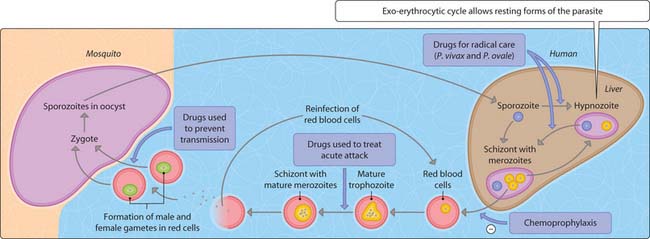48 Chemotherapy
antiprotozoan agents
Malaria
Malaria is transmitted by the Anopheles mosquito, which carries sporozoites of Plasmodium spp. that infect the human host when a mosquito bites (Fig. 3.48.1). The parasites infect liver cells and begin asexual division before being released into the blood as merozoites, which invade and multiply within red blood cells. Cell lysis releases the parasite into the bloodstream and gives rise to the clinical symptoms of malaria. Alternatively, some merozites differentiate into male and female gametocytes, which reenter a mosquito that bites an infected host and thus continue the parasite’s life cycle. P. falciparum causes the most deaths from malaria. A number of different drugs are available for the treatment of this disease (Table 3.48.1).
Table 3.48.1 Action of Antimalarial Drugs
| Stage | Effect | Drugs |
|---|---|---|
| Merozoites | Block the link between the exoerythrocytic and erythrocytic stages (chemoprophylactic) | 4-Aminoquinolines, antifolates, antibiotics, arteminsin |
| Erythrocytic forms | Can cure P. falciparum forms or P. malariae infections as these have no exoerythrocytic stage; suppress acute attack for P. vivax or P. ovale but the exoerythrocytic forms can cause later relapses | Quinoline-methanols, 4-aminoquinolines,halofantrine,arteminsin derivatives,antibiotics, antifolates |
| Tissue schizonts | Effect a radical cure by acting on the parasites inthe liver | 8-Aminoquinoline (primaquine), antibiotic (tetracycline),antifolates |
| Gametocytes | Reduce the spread of nfection | 8-Aminoquinoline (primaquine), arteminsin derivatives |
< div class='tao-gold-member'>
Stay updated, free articles. Join our Telegram channel

Full access? Get Clinical Tree





